Big Worlds On Small Screens Features Miyazaki — & Rebecca Fisher Discusses “Spirited Away”
~ by Rebecca Fisher
Introduction:
I feel like this entire column has been slowly building up to the introduction of this particular movie. Spirited Away is considered Hayao Miyazaki’s masterpiece: the highest grossing film in Japanese history, the first Studio Ghibli film to became a global hit, and the winner of the 2002 Academy Award for Best Animated Film.
It also happens to be the first Miyazaki film I ever saw, and I really wish I could go back in time in order to experience it all over again. Spirited Away was like nothing I had ever seen before, and I can vividly remember how utterly engrossing it was to watch this strange, beautiful and unpredictable story unfolding on the screen in front of me.
Premise:
Chihiro is seriously unhappy about having to leave her old school and move to a new neighbourhood. Despite the enthusiasm of her parents, she’s determined to be sulky about it. But on the way to their new house, Chihiro’s father takes a wrong turn. In the middle of the city, the family find themselves driving down an overgrown lane that leads to the entrance of what appears to be a huge abandoned fun park.
Chihiro is reluctant to go any further, but her parents seem strangely obsessed with exploring the place. Moving deeper into the extensive parklands, they come across a street of food-stalls packed with delicious looking food. Chihiro explores further, finding an imposing bathhouse situated on the other side of a bridge at the end of the street.
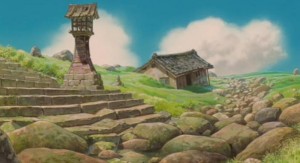 The eerie quiet of the abandoned theme park.
The eerie quiet of the abandoned theme park.
But as evening falls the spirit world comes alive. Soon the streets are filled with strange shadows, levitating masks and bizarre animal creatures. In horror Chihiro runs back to her parents, only to find that they’ve been turned into pigs.
To survive in this strange new world and have her parents restored to their human forms, Chihiro must get a job at the bathhouse, working for the intimidating old witch Yubaba, who runs the place, and serving the strange spirits who go there to replenish themselves.
Story:
It’s a surreal and frightening situation that Chihiro finds herself in – no less surreal and frightening than the film itself. Surrounded by mysterious figures such as the witch Yubaba, the bathhouse girl Lin and the stoic young Haku, Chihiro has no idea who to rely on. Everyone she meets can be dismissive and belittling, only to turn friendly and helpful on a whim. Who can she really trust?
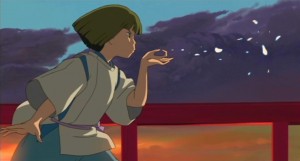 Haku tries to protect Chihiro – but who is he really?
Haku tries to protect Chihiro – but who is he really?
As well as that, she’s caught in a net of inexplicable rules, where strange gestures or incantations, or the act of not breathing in a certain place, are the only things keeping her safe. She only has her own determination and courage to navigate through the ever-shifting rules and unstable personalities around her. As such, it can be quite a harrowing film at times, with the tension derived not from any obvious danger, but the underlying feeling that any wrong move – however arbitrary – could have dire consequences.
This idea is ingrained into the way Miyazaki tells his story, which defies most Western conventions of how films are meant to be structured. There is no clear-cut mission or quest to be achieved, no full understanding of where Chihiro is or what she’s expected to do, and none of the familiar beats and rhythm of your standard fantasy story. Instead Chihiro is thrown into one bizarre situation after another, struggling to keep her head above water (sometimes literally), in an episodic and unpredictable manner that cannot be easily guessed in advance.
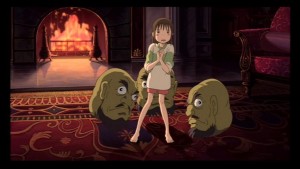 Chihiro begs Yubaba for a job.
Chihiro begs Yubaba for a job.
That said, there are some aspects of the film that are vaguely reminiscent of more familiar tales. When Chihiro and her parents enter the rundown entrance that leads to spirit world, there’s a “bigger on the inside” vibe reminiscent of the magical wardrobe in The Lion, the Witch and the Wardrobe. Her parents are turned into pigs by a witch’s power, much like Odysseus’s men on Circe’s island. Chihiro trying to assert herself in a world of random happenstance and moody creatures is also inevitably going to invite parallels to Alice in Wonderland.
And of course, the inexplicable rules such as not eating the food of the spirits and guarding one’s name against those who would use it to control you, are featured in all sorts of fairy tales around the world.
Characters:
As with many of Miyazaki’s films, the protagonist is a young female. But whereas the likes of Nausicaa, Sen and Arietty are competent and mature young women, Chihiro starts off as a rather whiny pre-teen who is determined to complain all the way to her new house.
Yet when her parents insist on exploring the old amusement park, you’re drawn in alongside her as the gradual shift from one world to the next takes place: first in the glimpse of little shrines along the side of the road, then by the sounds of a faraway train, and finally with the sprawling parklands that seem far too vast to be contained within a city.
 Chihiro grapples with manual labour.
Chihiro grapples with manual labour.
It’s impossible not to empathize with her when her life takes such a confusing downward turn, but over the course of the film she gradually assumes her responsibilities and demonstrates compassion and selflessness when it comes to caring for others. And as ever, the stunning animation makes her a fully dimensional character, capturing all her facial expressions, movement and body language. Little details are added just for the sake of it – such as when she gets out of the car and then doubles back in order to leave her bouquet of flowers in the backseat.
And she’s surrounded by all sorts of incredible creatures: a dragon, a giant baby, a pair of shape-shifting witches, three disembodied heads, origami birds, and spirits of every shape and colour. It’s a feast for the eyes, and I guarantee there’ll more than one moment in which you’re staring awestruck at the screen.
Conclusion:
At one-hundred-and-twenty-five minutes Spirited Away is a surprisingly long film for one that’s ostensibly aimed at children, but every second is packed full of some new wonderment. Tranquil scenes are interspersed with some rather terrifying depictions of spirits and witches, and Chihiro’s astonishment at it all mirrors our own.
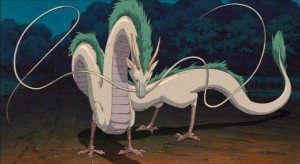 One of many incredible creatures on display.
One of many incredible creatures on display.
Perhaps a bit too scary for very young viewers (though not more so than some of the stuff that goes on in Disney films), Spirited Away is an undisputed classic. I watched it recently to refresh my memory for this column, and just writing about it makes me want to watch it again!
.
Next Time: Howl’s Moving Castle
On the heels of Spirited Away came Howl’s Moving Castle, based on the book by Diana Wynne Jones. But does the thematic depth of a Japanese animator mesh well with the sardonic wit of a British author? As we’ll see next time, Howl’s Moving Castle is a rather odd blend of two very different types of storytellers.
.
About The Reviewer:
 Rebecca Fisher is a graduate of the University of Canterbury with a Masters degree in English Literature, mainly, she claims, because she was able to get away with writing her thesis on C.S. Lewis and Philip Pullman. She is a reviewer for FantasyLiterature.com, a large website that specializes in fantasy and science-fiction novels, as well as posting reviews to Amazon.com and her LiveJournal blog.
Rebecca Fisher is a graduate of the University of Canterbury with a Masters degree in English Literature, mainly, she claims, because she was able to get away with writing her thesis on C.S. Lewis and Philip Pullman. She is a reviewer for FantasyLiterature.com, a large website that specializes in fantasy and science-fiction novels, as well as posting reviews to Amazon.com and her LiveJournal blog.To read Rebecca’s detailed introduction of both herself and the series, as well as preceding reviews, click on:

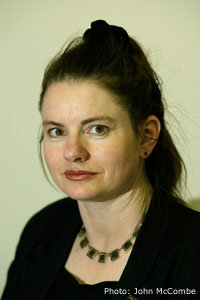

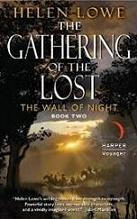
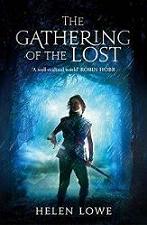
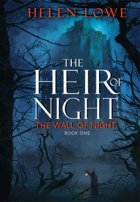



AMAZING film, huh? The first one I saw too and it stunned me. Especially the ‘stink’ spirit scene 😀
Watching that scene, you can practically SMELL the fumes coming off it.
“Spirited Away” edges out all the others to be my favourite Miyazaki. 🙂
And all the mud, so perfectly animated! 🙂
So hard for me to choose a favourite, painfully difficult 😀